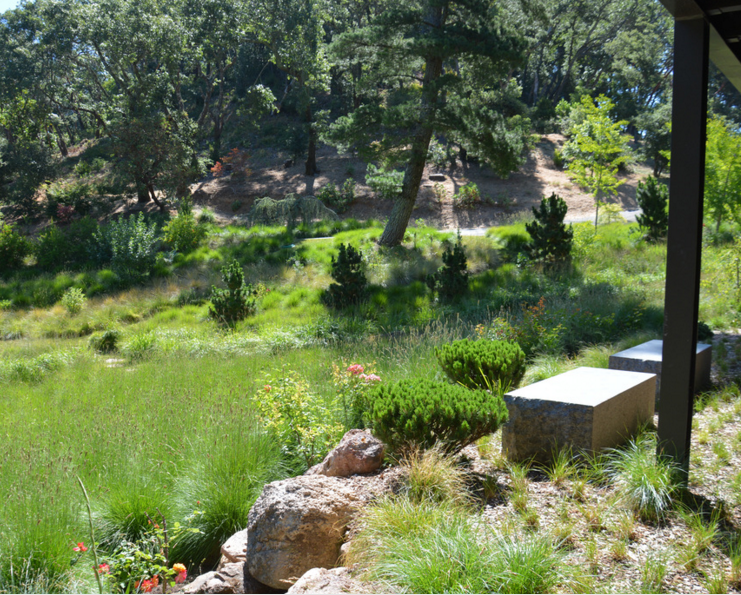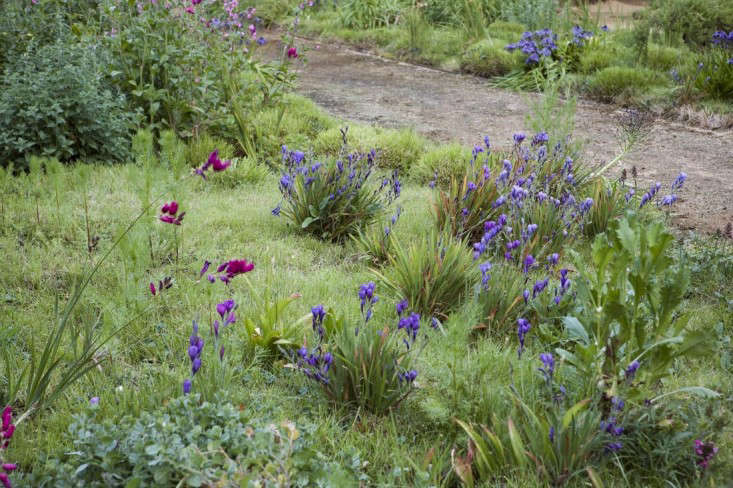John Greenlee paints with grasses. His colorful meadow gardens, created for clients around the world, are environmentally friendly alternatives to a traditional turf lawn. The Bay Area–based garden designer also raises and sells a wide variety of his favorite plants (many of which he has developed himself).
For anyone who wants to create a meadow garden, Greenlee’s books The American Meadow Garden ($38.34 from Amazon) and The Encyclopedia of Ornamental Grasses ($24.90 on Amazon) are indispensable bibles. Last week, we sat down with him and learned eight essential tips about how to replace a turf lawn with a blooming meadow garden:
Photography courtesy of Greenlee & Associates.
Size doesn’t matter.

“The smaller your garden, the more a little meadow makes sense,” says Greenlee. “And in a small space, a meadow is much sexier than a lawn. You can have a lot more interesting things going on in a meadow.”
Tip: In a small garden, keep the design simple. Choose a grass or grasses based on how you want to use a space: Do you want to walk across the meadow every now and again, or do you want to use it as a lawn, or mow a path through it?
Know your site.

“It’s like any other garden project: You have to know your soil, and you have to know your site conditions,” says Greenlee. “Understand how much shade you have and how many hours of shade, know the difference between a side that is in dappled shade and one that is in full sun.”
Tip: Start with the direction your garden faces. Does your garden have an eastern exposure (sun in the morning) or a southern exposure (the hottest) or a western exposure (shade in the morning, sun in the afternoon) or a northern exposure (the least sun)? Study the way the sun falls on your garden: Do you see microclimates that get more or fewer hours of sunlight than the rest of the garden? Look at how trees are sited: Where do they cast shade and at what time of day?
Kill your lawn ruthlessly.

“You have to get back to a clean slate and get rid of not only the living vegetation but also the weed seed that is in the soil and will start growing again as soon as you apply water to it,” says Greenlee. “There are organic ways to get the job done, but it takes time: You can haul away the top eight inches of soil, then start watering and see if anything else comes up. But there’s a carbon footprint to that because you’re hauling all that soil to a landfill.”
Tip: “I say spray Roundup. It’s the last time you’ll need it, and it doesn’t scare me to spray it to make sure all the disturbance ecology (like weed seed) is dead—and then never use it again,” says Greenlee. “If you don’t understand how chemicals work and hear the word ‘Roundup’ you get scared. Yes, constant use of chemicals in agriculture is absolutely a bad thing, but this is different. It’s a hormone that affects living green tissue, so you spray it on a plant that absorbs it and metabolizes it. That causes cell destruction and that plant dies.”
Don’t bother with soil amendment.

“Soil amendment is worthless. Raising a peat bog in Canada and shipping it to California to rototill it into the top eight inches of soil when you want your new roots to grow three feet down is a bad idea,” says Greenlee.
Tip: Instead, cover your dead lawn with bark mulch and plant grasses directly into the dead sod. “Done,” says Greenlee.
Create good bones.

“Grasses and grasslike plants are the backbone of the garden,” says Greenlee. “These are plants that can handle tree-root competition and be evergreen, even with very little water in summertime.”
Tip: Keep an open mind. Members of the lily family can behave like grasses. So can liriopes. So can lomandras (a genus of 51 species perennial herbs native to Australia).
Add seasonal accents.

“While grasses are the backbone of a meadow, the real fun comes in accessorizing them,” says Greenlee. “You can network other plants into the meadow so that no matter how big or small it is, people will look at your little patch of grass ecology and say, ‘look at that gorgeous little meadow.’ “
Tip: Plant spring bulbs, perennials, annuals, and flowering grasses to add successive waves of color to a meadow throughout the seasons.
Embrace a natural look.

“Nature abhors a monoculture, and rarely in nature will you see a monoculture of anything,” says Greenlee. “From a design perspective, make sure your meadow is a mix of plants that looks natural and says iconically, ‘I am a meadow.'”
Tip: To look like a real meadow, your garden must have movement. You’ll get movement from flowers, swaying grasses, and happy clumps of plants that have reseeded themselves.
Maintain the meadow.

I want people to be in my meadow and make pathways through them,” says Greenlee. “If you don’t have pathways, it’s a different kind of maintenance.”
Tip: Mow pathways from four to six times a year. With other grasses, mow once or twice a season or cut back seedheads in winter.
N.B.: For more of our favorite meadow gardens, see Lawn Begone: 7 New Ideas for Front Yard Landscaping and Vineyard Haven: A Napa Valley Garden that Belongs to the Land.














Have a Question or Comment About This Post?
Join the conversation (4)